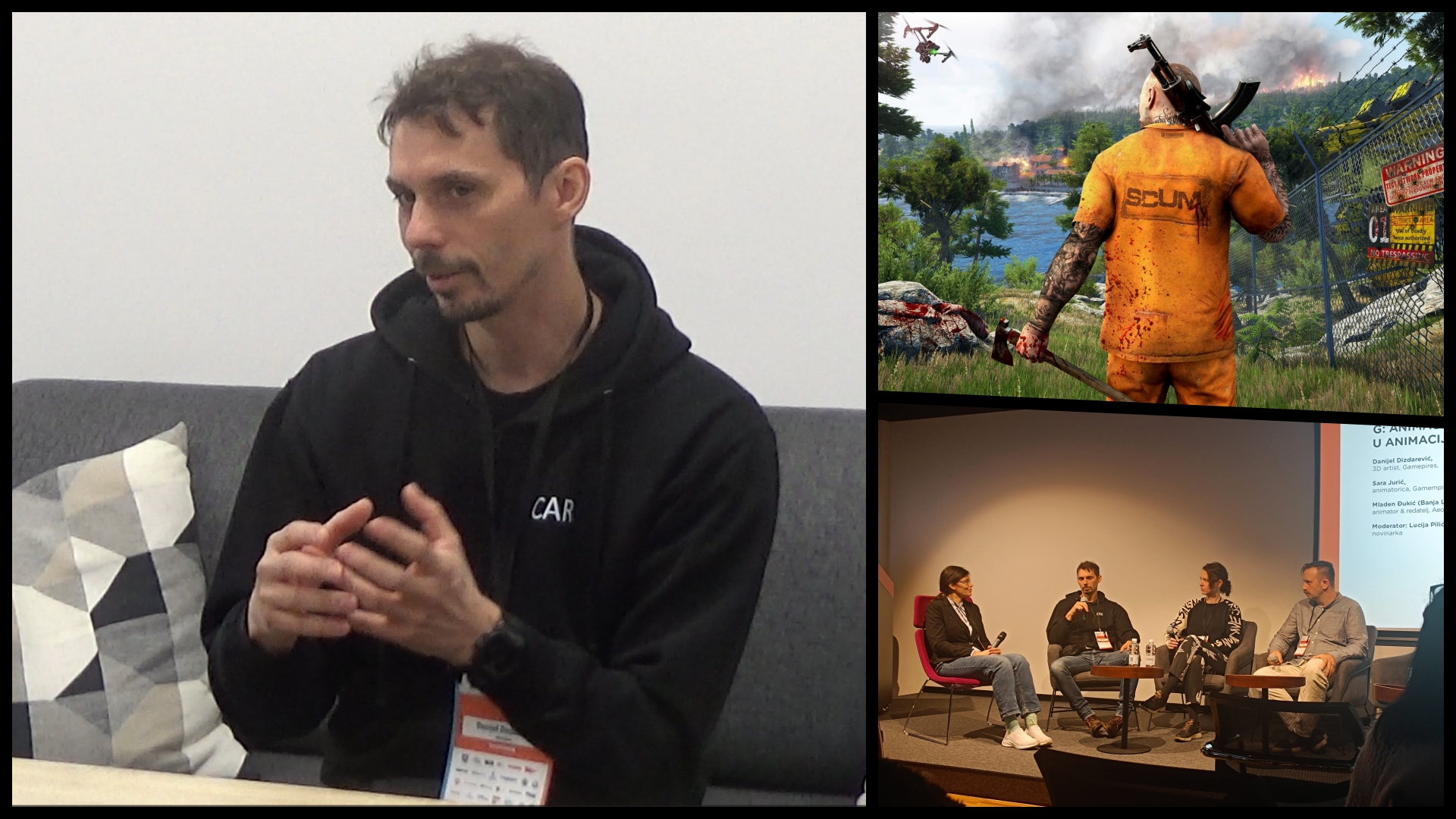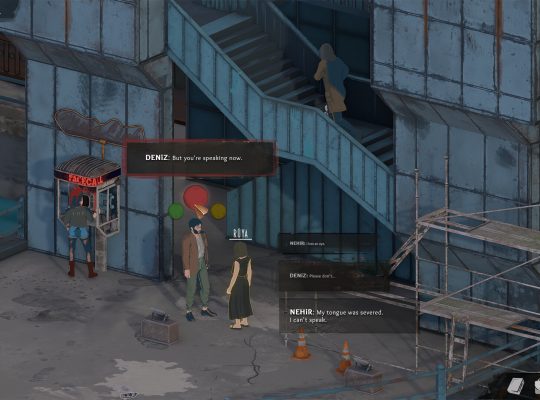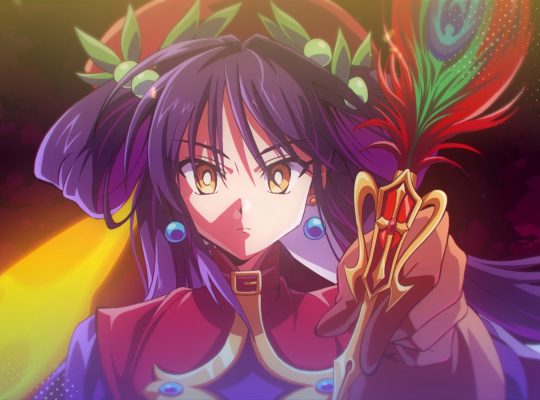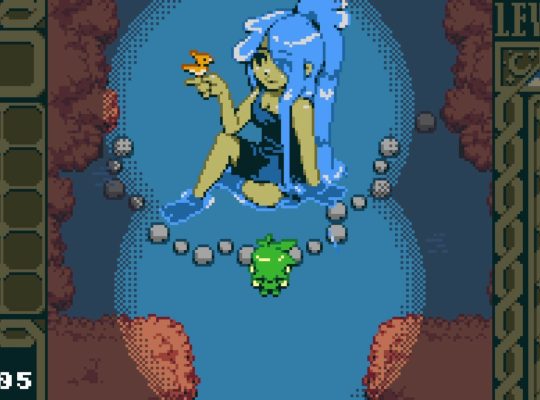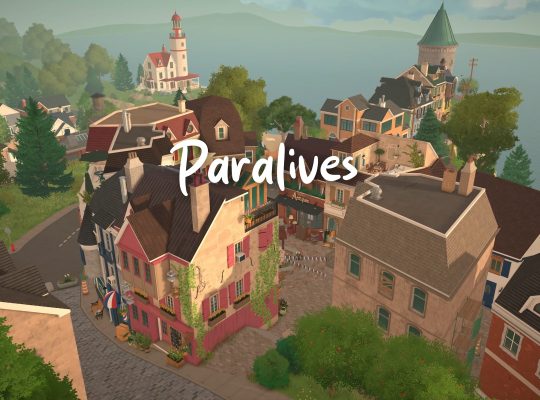Danijel Dizdarević is the lead character designer at the Croatian studio Gamepires, known for the game SCUM, which is now part of Jagex, the company that acquired the rights to this IP, and we met him during the Blender: Film & Games conference in Zagreb. Although it is a live-service game that continuously receives new content and updates, SCUM still attracts around 20 thousand active players.
Danijel also participated as a speaker on a panel titled Animation – Similarities and Differences in the Animation of Films and Video Games, along with his colleague Sara Jurić. We spoke with him about the role of character designers, his views on the gaming industry in Croatia, the situation in the studio after it was acquired by Jagex, as well as many other topics.
Otherwise, SCUM is a game that offers the possibility of exploration, looting, crafting items, and customizing outfits as well as the character itself. It provides an exceptionally immersive and hyper-realistic survival experience, where you have complete control over your progress. Gamepires also participated in this year's Infogamer, so we definitely recommend paying extra attention to this game.
What do you do in your job?
I am currently a lead character designer, which means I lead my team and convey the entire system we use in the game to them. Besides transferring knowledge and experience, I maintain their workflow at an appropriate level and am there for any problems and challenges that arise. We work with a quite complex system that has been developing for years, and it takes a lot of time for each new team member to get into all the processes. In short, my job is to maintain, train, and lead the team.
Which programs do you use most often in the studio?
From the very beginning of character creation to completion, we use various programs. For example, for high-poly models, we use Marvelous Designer for clothing and ZBrush for sculpting animals. We often use 3D scans, which we then clean up in ZBrush. We also use Blender, while animators are more on the Maya program. Sometimes we also work in 3D Coat, although we don't use it as much. After that, we use Substance Painter and Photoshop, all from the Adobe suite.
How long does it take to create a character?
It all depends on the complexity. If it's an NPC that doesn't have to meet specific requirements, it can be done in two weeks. However, for complex characters, it can take up to six months because the work is often interrupted by other tasks, such as making trailers or fixing previously completed parts. Some characters, due to their specificity in our game, require special specifications; for example, our system allows characters to lose or gain weight, which means we need to have four different states for each character: skinny, fat, muscular, and normal.
Do you have a character in SCUM that you are particularly proud of?
Yes, I would say it's the DLC character Danny Trejo. He was our first DLC character, and I mostly worked on him. We had some clothing prepared by a former colleague, and I worked on the head, adjusting the scans for the body, textures, and everything else. Danny Trejo is actually the first DLC I worked on, and later other team members took over the continuation of development under my supervision. This project is particularly dear to me because there were many technical challenges. I enjoyed working on it more than on the first characters where the whole process was still in the stage of defining and adjusting.




Has the situation in the team changed since Jagex took over?
Yes, the changes are noticeable, especially in the pace and the actual process of content implementation. Previously, we worked intensively and released new updates every other week. With Jagex's arrival, the process has slowed down because everything we create now needs to go through additional review and receive their approval. Jagex is now the owner of the IP, so they must confirm every new piece of content before it enters the game. This additional communication with them definitely slows down the process.
Are you now also working on projects for Jagex, like Runescape, or are you focused solely on SCUM?
Currently, we are exclusively focused on SCUM. We are not working on their projects, although something may appear in the future. They already have enough people on their projects, and our models are more complex and higher poly compared to theirs, which are more low poly. For now, we have enough work on our own project due to the complexity of our tasks.
How does the constant advancement of technology affect your job? Is it easier for you to work now?
Honestly, although people often comment that the models in the game have improved due to technological advancement, in my case, it's not quite like that. I work with almost the same tools as I did nine years ago, with minor upgrades. What has truly changed is my experience and ability to achieve better results with the same tools. People often think that advanced technology has made work easier, but in fact, the quality has increased because I, as an artist, have progressed.
What does the gaming industry in Croatia look like currently? Is it difficult to succeed as a character designer?
It's hard to find experienced character designers because most candidates are still at a junior or beginner level. While we were looking for new team members, it often became evident how rare experienced designers are in Croatia. Although it's not difficult to find a job in this industry, success depends on how much individuals work on themselves. It's important to go through the entire process of creating a model from start to finish to understand what makes a model quality and useful for the game. When candidates receive feedback, we appreciate it when they apply it in future applications because it shows a willingness to learn and improve. Besides technical knowledge, communication and the ability to accept suggestions are very important, which is crucial for teamwork and production in general.




Are you planning to stay at Gamepires or do you have any ambitions to work on other projects or games that you would like?
Given that I have three children and a family life, I don't have much time to consider new jobs or start my own projects. After almost nine years in this role, I have no plans to leave. I used to think about it, but I realized that my departure could cause difficulties because certain workflows and knowledge are still only in my head. A comprehensive guide would need to be created for taking over those tasks, so for now, I don't plan on making a change.
How often do you collaborate with the team on character stories? How important is the backstory to you when creating characters and atmosphere?
My main focus is on creating clothing for playable characters. When we work on NPCs like monsters, tribes, or savages, there may be some backstory, but ultimately we focus more on the technical aspects. For example, if an NPC has long clothing like a cloak or coat, it must be adapted to technical limitations, such as Unreal Engine 4's inability to support the combination of cloth physics and character shape changes. This means that the clothing must be "weighted" to the bones to function in the game, but the player cannot take and use that clothing due to technical limitations. So, while there is some backstory, our priority is aligning with the technical specifications within the game.
Are you planning to switch to Unreal Engine 5 or another engine?
From what I've heard so far, transitioning to Unreal Engine 5 would bring many challenges and potential problems, perhaps more than it would offer benefits. However, we never know what the future will bring; if the programming team finds a way to implement it without major difficulties, we might consider that option. But for now, there are no concrete plans.
How did you start with design? Is it something you've always wanted to do?
Actually, I discovered design a bit later. I have always loved drawing, especially graffiti and sketches on paper. At one point, I thought I would become a concept artist, and I was also interested in airbrushing engines, cars, and helmets. However, due to financial stability, I started exploring digital tools, so I switched to drawing in Photoshop. Then I transitioned from 2D to 3D to help myself with perspective, and over time, I became more focused on 3D modeling. After a few years of practice, I applied for a job, and that's how it all started.
What do you think about the Blender: Film & Games conference you participated in as a speaker?
I think it's a great idea! There has been a connection between movies and games for a long time, and I'm glad that discussions about it are being opened at such conferences. I only recently learned about the project and started preparing for participation, but I believe it is a valuable space for exchanging knowledge and experiences.




How do you deal with clothing clipping issues and similar technical challenges?
Clothing clipping, especially with characters, is something we simply have to come to terms with. With "hard surface" elements, like weapon parts, mistakes are unacceptable because we know exactly how those components should behave. However, with "soft surface" elements, such as clothing on characters, things are significantly more complex. We have morphs for different body types – skinny, fat, muscular, and normal – which complicates perfect fitting. Adding too many details or morphs would increase hardware requirements and decrease game performance, which players would find more bothersome than occasional clipping.
How many pieces of clothing do you currently have in the game?
We have hundreds of pieces of clothing, including shoes, pants, shirts, gloves, special full-body items, as well as male and female versions of each piece. Each piece of clothing must be made in four versions due to different body types. This means that each piece requires more morphs and adjustments, further increasing complexity.
How do you balance visual quality and game performance?
We always strive to optimize the game to run on a wider range of hardware, including lower-end configurations. Textures and models are often reduced for consoles to achieve better performance. Sometimes players do not understand why certain things, like texture details, are adjusted, but our goal is to achieve a balance between visual quality and technical feasibility.
Are you satisfied with the game's reception?
We are satisfied with what we've achieved, but we believe that SCUM deserves an even larger player base, especially compared to competing titles. Many competitor games do not have as many complex elements as SCUM, but their long-standing presence in the market and player nostalgia keep them ahead. Nevertheless, we continue to build on what we have and believe that over time we will attract an even broader audience.


